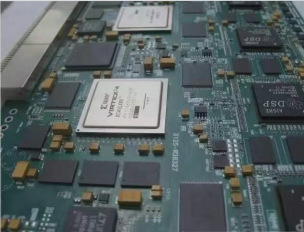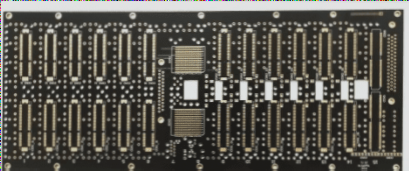**Introduction to the Advantages of PCB Circuit Board Wet Film**
First, let’s discuss the characteristics of the wet film.
1. **Good Adhesion and Coverage**
The wet film is a blue, viscous liquid synthesized from photosensitive resin, with added photosensitizers, colorants, fillers, and solvents. It adheres well to the substrate, effectively filling pits and scratches, and forms strong chemical bonds with the substrate. This results in excellent adhesion between the wet film and the copper foil on the substrate. Additionally, screen printing allows for uniform coverage, creating the conditions necessary for high-density, fine-line PCB processing.
2. **Excellent Resolution**
The contact and coverage between the wet film and the substrate are optimal. The light used for exposure passes through the film more directly, reducing optical path length and minimizing energy loss or errors due to light scattering. This leads to a resolution of the wet film typically below 25μm, which significantly improves the accuracy of pattern creation. In contrast, the actual resolution of dry films is often limited to around 50μm.

1. **The thickness of low-cost wet film is controllable**, typically thinner than dry film, and the packaging cost is also lower. In comparison, the cost of wet film is generally more affordable. The production speed of wet film in the inner layer of thin lines is significantly improved, and material costs are reduced by 20% compared to dry film.
2. **The development speed of the wet film increases by 30%**, and the etching rate also allows for more cycles of film loss. This results in faster melatonin processing, leading to energy savings, better equipment utilization, and ultimately, reduced costs.
3. **Eliminating board edge hair**
The edges of dry film boards are prone to fraying, which can lead to film breakage, negatively affecting the yield during the PCB production process. In contrast, wet film boards do not exhibit film breakage or edge fraying.
4. **Main operating considerations for wet film applications**
The material from the previous process (i.e., board production) for the brush board must not be excessively oxidized, oil-contaminated, or wrinkled. We use a pickling process (5% sulfuric acid) to spray and remove organic impurities and inorganic dirt. After this, a 500-mesh nylon roller abrasive brush is used for cleaning. Once brushed, the board should show no oxidation on the copper surface, have a uniform roughness, smoothness, and no water stains. This treatment enhances the adhesion of the wet film to the copper foil surface, ensuring it meets the requirements for subsequent processes.
5. **The condition of the copper foil surface after brushing directly impacts PCB output.**
To meet the required wet film thickness, it is essential to pay attention to the screen thickness and the number of lines (i.e., lines per unit length) when selecting the screen. The film thickness is related to the ink flux through the metal screen. The theoretical ink transmittance (UTH) is given by:
[
UTH = DW^2 times left( frac{(w + d)^2}{1000} right)
]
where D is the clean sand thickness, d is the line diameter, and w is the opening width. The actual ink permeability is also influenced by the wet film viscosity, scraping pressure, and scraping speed. To achieve uniform coverage, the scraper edge must be ground properly. The thickness of the back platen mask should be controlled between 15-25μm. If the film is too thick, it may cause underexposure, poor development, and difficult pre-drying, leading to on-site film issues and operational challenges. Conversely, a film that is too thin can lead to excessive exposure, poor corrosion resistance, weak electroplating insulation, and difficult film handling.
6. **For fine lines below 0.15mm**, the film thickness should be less than 20μm after application.
7. **Before applying the wet film**, adjust its viscosity, stir well, and allow it to stand for 15 minutes to eliminate static. Ensure the screen printing room is clean to avoid foreign particles contaminating the surface, which could affect the board’s pass rate. The temperature should be maintained at around 20°C with a relative humidity of approximately 50%.
8. **Pre-drying and drying parameters**: The first side should be baked at 80-100°C for 7-10 minutes, and the second side should be baked at 80-100°C for 10-20 minutes. Pre-drying is primarily to evaporate the solvent in the ink. Proper pre-baking is crucial for wet film applications. Inadequate pre-baking can cause the film to stick to the board during storage and handling, or it may stick to the negative film during exposure, leading to wire breakage or short circuits. Over-drying can cause poor development, leaving the edges of the lines jagged. Pre-drying directly impacts PCB quality, so it is a critical step in removing the unexposed portions of the wet film layer to achieve the desired circuit pattern.
9. **Strictly control the developer concentration (10-12g/L)**, temperature (30-34°C), and developer concentration. Incorrect concentration levels can lead to incomplete development. Optimize the development speed to match exposure, and frequently clean the nozzle to ensure consistent nozzle pressure and distribution.
10. **Excessive development time or high development temperature** can lead to deterioration of the wet film surface, causing severe permeability or lateral erosion during electroplating or acid etching, thus reducing the pattern accuracy required. The etching solution can include alkaline iron chloride, acid copper chloride, or ammonia. Different copper foil thicknesses require different etching speeds and solution temperatures. Consistently maintain uniform pressure and spray distribution from the etching machine nozzle to avoid uneven corrosion, which could affect edge copper wires and compromise PCB quality.
11. **The membrane used in PCB factories typically employs a 4-7% sodium hydroxide solution at 50-60°C**, which is mainly used to expand and subdivide the membrane structure, also aiding in fading within the wet film’s pores. Wet film can also be used for pattern transfer on special double-sided panels, yielding good results.
First, let’s discuss the characteristics of the wet film.
1. **Good Adhesion and Coverage**
The wet film is a blue, viscous liquid synthesized from photosensitive resin, with added photosensitizers, colorants, fillers, and solvents. It adheres well to the substrate, effectively filling pits and scratches, and forms strong chemical bonds with the substrate. This results in excellent adhesion between the wet film and the copper foil on the substrate. Additionally, screen printing allows for uniform coverage, creating the conditions necessary for high-density, fine-line PCB processing.
2. **Excellent Resolution**
The contact and coverage between the wet film and the substrate are optimal. The light used for exposure passes through the film more directly, reducing optical path length and minimizing energy loss or errors due to light scattering. This leads to a resolution of the wet film typically below 25μm, which significantly improves the accuracy of pattern creation. In contrast, the actual resolution of dry films is often limited to around 50μm.

1. **The thickness of low-cost wet film is controllable**, typically thinner than dry film, and the packaging cost is also lower. In comparison, the cost of wet film is generally more affordable. The production speed of wet film in the inner layer of thin lines is significantly improved, and material costs are reduced by 20% compared to dry film.
2. **The development speed of the wet film increases by 30%**, and the etching rate also allows for more cycles of film loss. This results in faster melatonin processing, leading to energy savings, better equipment utilization, and ultimately, reduced costs.
3. **Eliminating board edge hair**
The edges of dry film boards are prone to fraying, which can lead to film breakage, negatively affecting the yield during the PCB production process. In contrast, wet film boards do not exhibit film breakage or edge fraying.
4. **Main operating considerations for wet film applications**
The material from the previous process (i.e., board production) for the brush board must not be excessively oxidized, oil-contaminated, or wrinkled. We use a pickling process (5% sulfuric acid) to spray and remove organic impurities and inorganic dirt. After this, a 500-mesh nylon roller abrasive brush is used for cleaning. Once brushed, the board should show no oxidation on the copper surface, have a uniform roughness, smoothness, and no water stains. This treatment enhances the adhesion of the wet film to the copper foil surface, ensuring it meets the requirements for subsequent processes.
5. **The condition of the copper foil surface after brushing directly impacts PCB output.**
To meet the required wet film thickness, it is essential to pay attention to the screen thickness and the number of lines (i.e., lines per unit length) when selecting the screen. The film thickness is related to the ink flux through the metal screen. The theoretical ink transmittance (UTH) is given by:
[
UTH = DW^2 times left( frac{(w + d)^2}{1000} right)
]
where D is the clean sand thickness, d is the line diameter, and w is the opening width. The actual ink permeability is also influenced by the wet film viscosity, scraping pressure, and scraping speed. To achieve uniform coverage, the scraper edge must be ground properly. The thickness of the back platen mask should be controlled between 15-25μm. If the film is too thick, it may cause underexposure, poor development, and difficult pre-drying, leading to on-site film issues and operational challenges. Conversely, a film that is too thin can lead to excessive exposure, poor corrosion resistance, weak electroplating insulation, and difficult film handling.
6. **For fine lines below 0.15mm**, the film thickness should be less than 20μm after application.
7. **Before applying the wet film**, adjust its viscosity, stir well, and allow it to stand for 15 minutes to eliminate static. Ensure the screen printing room is clean to avoid foreign particles contaminating the surface, which could affect the board’s pass rate. The temperature should be maintained at around 20°C with a relative humidity of approximately 50%.
8. **Pre-drying and drying parameters**: The first side should be baked at 80-100°C for 7-10 minutes, and the second side should be baked at 80-100°C for 10-20 minutes. Pre-drying is primarily to evaporate the solvent in the ink. Proper pre-baking is crucial for wet film applications. Inadequate pre-baking can cause the film to stick to the board during storage and handling, or it may stick to the negative film during exposure, leading to wire breakage or short circuits. Over-drying can cause poor development, leaving the edges of the lines jagged. Pre-drying directly impacts PCB quality, so it is a critical step in removing the unexposed portions of the wet film layer to achieve the desired circuit pattern.
9. **Strictly control the developer concentration (10-12g/L)**, temperature (30-34°C), and developer concentration. Incorrect concentration levels can lead to incomplete development. Optimize the development speed to match exposure, and frequently clean the nozzle to ensure consistent nozzle pressure and distribution.
10. **Excessive development time or high development temperature** can lead to deterioration of the wet film surface, causing severe permeability or lateral erosion during electroplating or acid etching, thus reducing the pattern accuracy required. The etching solution can include alkaline iron chloride, acid copper chloride, or ammonia. Different copper foil thicknesses require different etching speeds and solution temperatures. Consistently maintain uniform pressure and spray distribution from the etching machine nozzle to avoid uneven corrosion, which could affect edge copper wires and compromise PCB quality.
11. **The membrane used in PCB factories typically employs a 4-7% sodium hydroxide solution at 50-60°C**, which is mainly used to expand and subdivide the membrane structure, also aiding in fading within the wet film’s pores. Wet film can also be used for pattern transfer on special double-sided panels, yielding good results.




